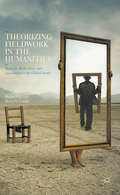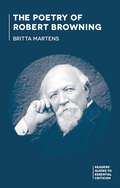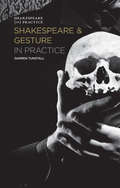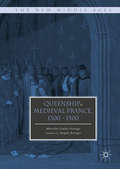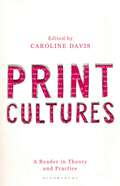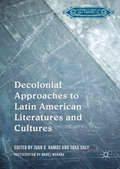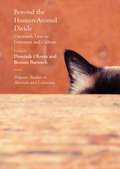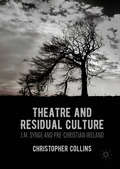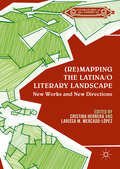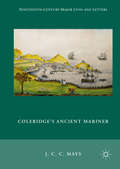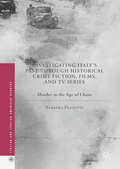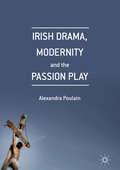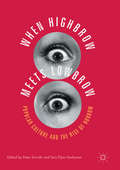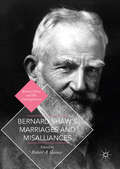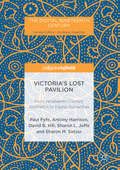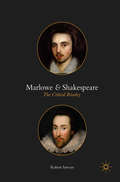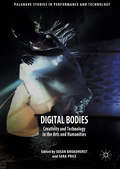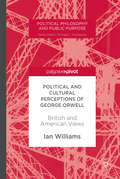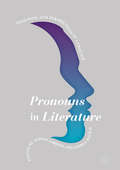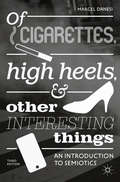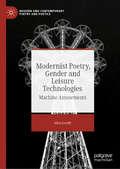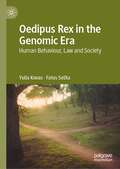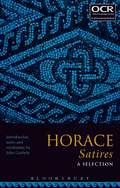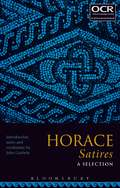- Table View
- List View
Theorizing Fieldwork in the Humanities: Methods, Reflections, and Approaches to the Global South
by Shalini Puri and Debra A. CastilloThis volume, the first of its kind, launches a conversation amongst humanities scholars doing fieldwork on the global south. It both offers indispensable tools and demonstrates the value of such work inside and outside of the academy. The contributors reflect upon their experiences of fieldwork, the methods they improvised, their dilemmas and insights, and the ways in which fieldwork shifted their frames of analysis. They explore how to make fieldwork legible to their disciplines and how fieldwork might extend the work of the humanities. The volume is for both those who are already deeply immersed in fieldwork in the humanities and those who are seeking ways to undertake it.
The Poetry of Robert Browning (Readers' Guides to Essential Criticism)
by Britta MartensRobert Browning's pre-eminent status amongst Victorian poets has endured despite the recent broadening of the literary canon. He is the main practitioner of the period's most important poetic genre, the dramatic monologue, while his engagement with many aspects of nineteenth-century culture makes him a key figure in the wider field of Victorian studies. This stimulating introduction to Browning criticism provides an overview of the major responses to the poet’s work over the last two hundred years. It offers an insightful guide to criticism from various theoretical perspectives, elucidating Browning’s participation in Victorian debates about aesthetics, history, politics, religion, gender and psychology.
Shakespeare and Gesture in Practice: Shakespeare in Practice (Shakespeare in Practice)
by Darren TunstallWhen actors perform Shakespeare, what do they do with their bodies? How do they display to the spectator what is hidden in the imagination? This is a history of Shakespearean performance as seen through the actor's body. Tunstall draws upon social, cognitive and moral psychology to reveal how performers from Sarah Siddons to Ian McKellen have used the language of gesture to reflect the minds of their characters and shape the reactions of their audiences. This book is rich in examples, including detailed analysis of recent performances and interviews with key figures from the worlds of both acting and gesture studies. Truly interdisciplinary, this provocative and original contribution will appeal to anyone interested in Shakespeare, theatre history, psychology or body language.
Queenship in Medieval France, 1300-1500 (The New Middle Ages)
by Murielle Gaude-FerraguThis book examines the power held by the French medieval queens during the fourteenth and fifteenth centuries and their larger roles within the kingdom at a time when women were excluded from succession to the throne. Well before Catherine and Marie de’ Medici, the last medieval French queens played an essential role in the monarchy, not only because they bore the weight of their dynasty’s destiny but also because they embodied royal majesty alongside their husbands. Since women were excluded from the French crown in 1316, they were only deemed as “queen consorts.” Far from being confined solely to the private sphere, however, these queens participated in the communication of power and contributed to the proper functioning of “court society.” From Isabeau of Bavaria and her political influence during her husband’s intermittent absences to Anne of Brittany’s reign, this book sheds light on the meaning and complexity of the office of queen and ultimately the female history of power.
Print Cultures: A Reader in Theory and Practice
by Caroline DavisThis reader is the most comprehensive selection of key texts on twentieth and twenty-first century print culture yet compiled. Illuminating the networks and processes that have shaped reading, writing and publishing, the selected extracts also examine the effect of printed and digital texts on society. Featuring a general introduction to contemporary print culture and publishing studies, the volume includes 42 influential and innovative pieces of writing, arranged around themes such as authorship, women and print culture, colonial and postcolonial publishing and globalisation. Offering a concise survey of critical work, this volume is an essential companion for students of Literature or Publishing with an interest in the history of the book.
Decolonial Approaches to Latin American Literatures and Cultures (Literatures of the Americas)
by Juan G. Ramos Tara DalyDecolonial Approaches to Latin American Literatures and Cultures engages and problematizes concepts such as “decolonial” and “coloniality” to question methodologies in literary and cultural scholarship. While the eleven contributions produce diverse approaches to literary and cultural texts ranging from Pre-Columbian to contemporary works, there is a collective questioning of the very idea of “Latin America,” what “Latin American” contains or leaves out, and the various practices and locations constituting Latinamericanism. This transdisciplinary study aims to open an evolving corpus of decolonial scholarship, providing a unique entry point into the literature and material culture produced from precolonial to contemporary times.
Beyond the Human-Animal Divide: Creaturely Lives in Literature and Culture (Palgrave Studies in Animals and Literature)
by Dominik Ohrem Roman BartoschThis volume explores the potential of the concept of the creaturely for thinking and writing beyond the idea of a clear-cut human-animal divide, presenting innovative perspectives and narratives for an age which increasingly confronts us with the profound ecological, ethical and political challenges of a multispecies world. The text explores written work such as Samuel Beckett’s Worstward Ho and Michel Foucault's The Order of Things, video media such as the film "Creature Comforts" and the video game Into the Dead, and photography. With chapters written by an international group of philosophers, literary and cultural studies scholars, historians and others, the volume brings together established experts and forward-thinking early career scholars to provide an interdisciplinary engagement with ways of thinking and writing the creaturely to establish a postanthropocentric sense of human-animal relationality.
Theatre and Residual Culture: J.M. Synge and Pre-Christian Ireland
by Christopher CollinsThis book considers the cultural residue from pre-Christian Ireland in Synge’s plays and performances. By dramatising a residual culture in front of a predominantly modern and political Irish Catholic middle class audience, the book argues that Synge attempted to offer an alternative understanding of what it meant to be “modern” at the beginning of the twentieth century. The book draws extensively on Synge’s archive to demonstrate how pre-Christian residual culture informed not just how he wrote and staged pre-Christian beliefs, but also how he thought about an older, almost forgotten culture that Catholic Ireland desperately wanted to forget. Each of Synge’s plays is considered in an individual chapter, and they identify how Synge’s dramaturgy was informed by pre-Christian beliefs of animism, pantheism, folklore, superstition and magical ritual.
**Missing** (Literatures of the Americas)
by Cristina Herrera Larissa M. Mercado-LópezThis book broadens the scope of Latina/o criticism to include both widely-read and understudied nineteenth through twenty-first century fictional works that engage in critical discussions of gender, race, sexuality, and identity. The essays in this collection do not simply seek inclusion for the texts they critically discuss, but suggest that we more thoughtfully consider the utility of mapping, whether we are mapping land, borders, time, migration, or connections and disconnections across time and space. Using new and rigorous methodological approaches to reading Latina/o literature, contributors reveal a varied and textured landscape, challenging us to reconsider the process and influence of literary production across borders.
Coleridge's Ancient Mariner (Nineteenth-Century Major Lives and Letters)
by J. C. MaysThis is the first book-length study to read the "Ancient Mariner" as "poetry," in Coleridge's own particular sense of the word. Coleridge's complicated relationship with the "Mariner" as an experimental poem lies in its origin as a joint project with Wordsworth. J. C. C. Mays traces the changes in the several versions published in Coleridge's lifetime and shows how Wordsworth's troubled reaction to the poem influenced its subsequent interpretation. This is also the first book to situate the "Mariner" in the context of the entirety of Coleridge's prose and verse, now available in the Bollingen Collected edition and Notebooks; that is, not only in relation to other poems like "The Ballad of the Dark Ladiè" and "Alice du Clós," but also to ideas in his literary criticism (especially Biographia Literaria), philosophy, and theology. Using a combination of close reading and broad historical considerations, reception theory, and book history, Mays surveys the poem's continuing life in illustrated editions and educational textbooks; its passage through the vicissitudes of New Criticism and critical theory; and, in a final chapter, its surprising affinities with some experimental poems of the present time.
Investigating Italy's Past through Historical Crime Fiction, Films, and TV Series: Murder in the Age of Chaos (Italian and Italian American Studies)
by Barbara PezzottiThis book is the first monograph in English that comprehensively examines the ways in which Italian historical crime novels, TV series, and films have become a means to intervene in the social and political changes of the country. This study explores the ways in which fictional representations of the past mirror contemporaneous anxieties within Italian society in the work of writers such as Leonardo Sciascia, Andrea Camilleri, Carlo Lucarelli, Francesco Guccini, Loriano Macchiavelli, Marcello Fois, Maurizio De Giovanni, and Giancarlo De Cataldo; film directors such as Elio Petri, Pietro Germi, Michele Placido, and Damiano Damiani; and TV series such as the “Commissario De Luca” series, the “Commissario Nardone” series, and “Romanzo criminale–The series.” Providing the most wide-ranging examination of this sub-genre in Italy, Barbara Pezzotti places works set in the Risorgimento, WWII, and the Years of Lead in the larger social and political context of contemporary Italy.
Irish Drama, Modernity and the Passion Play
by Alexandra PoulainThis book discusses Irish Passion plays (plays that rewrite or parody the story of the Passion of Christ) in modern Irish drama from the Irish Literary Revival to the present day. It offers innovative readings of such canonical plays as J. M. Synge’s The Playboy of the Western World, W. B. Yeats’s Calvary, Brendan Behan’s The Hostage, Samuel Beckett’s Endgame, Brian Friel’s Faith Healer and Tom Murphy’s Bailegangaire, as well as of less well-known plays by Padraic Pearse, Lady Gregory, G. B. Shaw, Seán O’Casey, Denis Johnston, Samuel Beckett and David Lloyd. Challenging revisionist readings of the rhetoric of “blood sacrifice” and martyrdom in the Irish Republican tradition, it argues that the Passion play is a powerful political genre which centres on the staged death of the (usually male) protagonist, and makes visible the usually invisible violence perpetrated both by colonial power and by the postcolonial state in the name ofmodernity.
When Highbrow Meets Lowbrow: Popular Culture and the Rise of Nobrow
by Peter Swirski Tero Eljas VanhanenThis book examines nobrow, a cultural formation that intertwines art and entertainment into an identifiable creative force. In our eclectic and culturally turbocharged world, the binary of highbrow vs. lowbrow is incapable of doing justice to the complexity and artistry of cultural production. Until now, the historical power, aesthetic complexity, and social significance of nobrow “artertainment” have escaped analysis. This book rectifies this oversight. Smart, funny, and iconoclastic, it scrutinizes the many faces of nobrow, throwing surprising light on the hazards and rewards of traffic between high entertainment and genre art.
Bernard Shaw's Marriages and Misalliances (Bernard Shaw and His Contemporaries)
by Robert A. GainesThis book combines the insights of thirteen Shavian scholars as they examine the themes of marriage, relationships and partnerships throughout all of Bernard Shaw’s major works. It also connects Shaw’s own experiences of love and marriage to the themes that emerge in his works, showing how his personal relationships in and out of matrimonial bonds change the ways his characters enter and exit marriages and misalliances. While providing a wealth of new analysis, this collection of essays also leaves lingering questions for the reader to spark continuing dialogue in both individual and academic settings.
Victoria's Lost Pavilion: From Nineteenth-Century Aesthetics to Digital Humanities (The Digital Nineteenth Century)
by Paul Fyfe Antony Harrison David B. Hill Sharon L. Joffe Sharon M. SetzerThis book explores the significance of the now-lost pavilion built in the Buckingham Palace Gardens in the time of Queen Victoria for understanding experiments in British art and architecture at the outset of the Victorian era. It introduces the curious history of the garden pavilion, its experimental contents, the controversies of its critical reception, and how it has been digitally remediated. The chapters discuss how the pavilion, decorated with frescos and encaustics by some of the most prominent painters of the mid-nineteenth century, became the center of a national conversation about an identity for British art, the capacity of its artists, and the quality of Royal and public taste.Beyond an examination of the pavilion's history, this book also introduces a digital model which restores the pavilion to virtual life, underscoring the importance of the pavilion for Victorian aesthetics and culture.
Marlowe and Shakespeare: The Critical Rivalry
by Robert SawyerInstead of asserting any alleged rivalry between Marlowe and Shakespeare, Sawyer examines the literary reception of the two when the writers are placed in tandem during critical discourse or artistic production. Focusing on specific examples from the last 400 years, the study begins with Robert Greene’s comments in 1592 and ends with the post-9/11 and 7/7 era.The study not only looks at literary critics and their assessments, but also at playwrights such as Aphra Behn, novelists such as Anthony Burgess, and late twentieth-century movie and theatre directors. The work concludes by showing how the most recent outbreak of Marlowe as Shakespeare’s ghostwriter accelerates due to a climate of conspiracy, including “belief echoes,” which presently permeate our cultural and critical discourse.
Digital Bodies: Creativity and Technology in the Arts and Humanities (Palgrave Studies in Performance and Technology)
by Sara Price Susan BroadhurstThis book explores technologies related to bodily interaction and creativity from a multi-disciplinary perspective. By taking such an approach, the collection offers a comprehensive view of digital technology research that both extends our notions of the body and creativity through a digital lens, and informs of the role of technology in practices central to the arts and humanities. Crucially, Digital Bodies foregrounds creativity, the interrogation of technologies and the notion of embodiment within the various disciplines of art, design, performance and social science. In doing so, it explores a potential or virtual new sense of the embodied self. This book will appeal to academics, practitioners and those with an interest in not only how digital technologies affect the body, but also how they can enhance human creativity.
Political and Cultural Perceptions of George Orwell: British and American Views (Political Philosophy and Public Purpose)
by Ian WilliamsThis book analyzes George Orwell’s politics and their reception across both sides of the Atlantic. It considers Orwell’s place in the politics of his native Britain and his reception in the USA, where he has had some of his most fervent emulators, exegetists, and detractors. Written by an ex “teenage Maoist” from Liverpool, UK, who now lives and writes in New York, the book points out how often the different strands of opinion derive from “ancestral” ideological struggles within the Communist/Trotskyist movement in the 30’s, and how these often overlook or indeed consciously ignore the indigenous British politics and sociology that did so much to influence Orwell’s political and literary development. It examines in the modern era what Orwell did in his–the seductions of simplistic and absolutist ideologies for some intellectuals, especially in their reactions to Orwell himself.
Pronouns in Literature: Positions and Perspectives in Language
by Alison Gibbons Andrea MacraeThis edited collection brings together an international, interdisciplinary group of scholars who together offer cutting-edge insights into the complex roles, functions, and effects of pronouns in literary texts. The book engages with a range of text-types, including poetry, drama, and prose from different periods and regions, in English and in translation. Beginning with analyses of the first-person pronoun, it moves onto studies of the subject dynamics of first- and second-person, before considering plural modes of narration and how pronoun use can help to disperse narrative perspective. The volume then debates the functional constraints of pronouns in fictional contexts and finally reflects upon the theoretical advancements presented in the collection. This innovative volume will appeal to students and scholars of linguistics, stylistics and cognitive poetics, narratology, theoretical and applied linguistics, psychology and literary criticism.
Of Cigarettes, High Heels, and Other Interesting Things: An Introduction to Semiotics (Semaphores And Signs Ser.)
by Marcel DanesiThis book deals with one the most interesting aspects of human life—the search for meaning. It discusses how the science of semiotics is equipped to provide insight on what meaning is and how we produce it. Why is it that certain people routinely put their survival at risk by smoking? Why is it that some women make locomotion difficult for themselves by donning high-heel footwear? Are there unconscious forces at work behind such strange behaviors? This book will attempt to answer such questions by claiming that these behaviors are meaningful in culture-specific ways. The discipline that studies such behaviors and their relation to meanings is called semiotics. Semiotics probes the human condition in its own peculiar way, by unraveling the meanings of signs, which motivate not only the wearing of high heel shoes, but also the construction of words and art forms. Now in its third edition, this landmark introduction to semiotics has been updated with a wealth of new content, focusing on the many developments in digital culture since the previous edition. With the addition of topics such as memes, Selfies, social media profiles, and even Mafia discourse, the new edition comprehensively covers new trends in culture while streamlining treatments of basic semiotics contents.
Of Cigarettes, High Heels, and Other Interesting Things: An Introduction to Semiotics
by Marcel DanesiThis book deals with one the most interesting aspects of human life—the search for meaning. It discusses how the science of semiotics is equipped to provide insight on what meaning is and how we produce it. Why is it that certain people routinely put their survival at risk by smoking? Why is it that some women make locomotion difficult for themselves by donning high-heel footwear? Are there unconscious forces at work behind such strange behaviors? This book will attempt to answer such questions by claiming that these behaviors are meaningful in culture-specific ways. The discipline that studies such behaviors and their relation to meanings is called semiotics. Semiotics probes the human condition in its own peculiar way, by unraveling the meanings of signs, which motivate not only the wearing of high heel shoes, but also the construction of words and art forms. Now in its third edition, this landmark introduction to semiotics has been updated with a wealth of new content, focusing on the many developments in digital culture since the previous edition. With the addition of topics such as memes, Selfies, social media profiles, and even Mafia discourse, the new edition comprehensively covers new trends in culture while streamlining treatments of basic semiotics contents.
Modernist Poetry, Gender and Leisure Technologies: Machine Amusements (Modern and Contemporary Poetry and Poetics)
by Alex GoodyModernist Poetry, Gender and Leisure Technologies: Machine Amusements explores how modernist women poets were inspired by leisure technologies to write new versions of the gendered subject. Focusing on American women writers and particularly on the city of New York, the book argues that the poetry of modernist women that engages with, examines or critiques the new leisure technologies of their era is fundamentally changed by the encounter with that technology. The chapters in the book focus on shopping, advertising, dance, film, radio and phonography, on city spaces such as Coney Island, Greenwich Village and Harlem, and on poetry that embraces the linguistic and formal innovations of modernism whilst paying close attention to the embodied politics of gender. The technologized city, and the leisure cultures and media forms emerging from it, enabled modernist women writers to re-imagine forms of lyric embodiment, inspired by the impact of technology on modern ideas of selfhood and subjectivity.
Oedipus Rex in the Genomic Era: Human Behaviour, Law and Society
by Yulia Kovas Fatos SelitaThis book explores the answers to fundamental questions about the human mind and human behaviour with the help of two ancient texts. The first is Oedipus Rex (Oedipus Tyrannus) by Sophocles, written in the 5th century BCE. The second is human DNA, with its origins around 4 billion years ago, and continuously revised by chance and evolution. With Sophocles as a guide, the authors take a journey into the Genomic era, an age marked by ever-expanding insights into the human genome. Over the course of this journey, the book explores themes of free will, fate, and chance; prediction, misinterpretation, and the burden that comes with knowledge of the future; self-fulfilling and self-defeating prophecies; the forces that contribute to similarities and differences among people; roots and lineage; and the judgement of oneself and others.Using Oedipus Rex as its lens, this novel work provides an engaging overview of behavioural genetics that demonstrates its relevance across the humanities and the social and life sciences. It will appeal in particular to students and scholars of genetics, education, psychology, sociology, and law.
Horace Satires: A Selection
by John GodwinThis is the endorsed publication from OCR and Bloomsbury for the Latin AS and A-Level (Group 3) prescription of Horace's Satires, giving full Latin text, commentary and vocabulary for Satires 1.1 lines 1–12, 28–100; 1.3 lines 25–75; and 2.2 lines 1–30, 70–111. A detailed introduction places the poems in their Roman literary context.'Telling the truth with a smile' is the way Horace describes his approach to satire in this, his first published poetry. The poems in this collection discuss universal ideas of how we should live our lives simply with regard to money, ambition, food and friendship and how to live contented with what nature provides rather than always yearning for more. The poet does this in a manner which is light but not flippant, always entertaining and powerfully moving at the same time.Resources are available on the Companion Website www.bloomsbury.com/ocr-editions-2019-2021
Horace Satires: A Selection
by John GodwinThis is the endorsed publication from OCR and Bloomsbury for the Latin AS and A-Level (Group 3) prescription of Horace's Satires, giving full Latin text, commentary and vocabulary for Satires 1.1 lines 1–12, 28–100; 1.3 lines 25–75; and 2.2 lines 1–30, 70–111. A detailed introduction places the poems in their Roman literary context.'Telling the truth with a smile' is the way Horace describes his approach to satire in this, his first published poetry. The poems in this collection discuss universal ideas of how we should live our lives simply with regard to money, ambition, food and friendship and how to live contented with what nature provides rather than always yearning for more. The poet does this in a manner which is light but not flippant, always entertaining and powerfully moving at the same time.Resources are available on the Companion Website www.bloomsbury.com/ocr-editions-2019-2021
